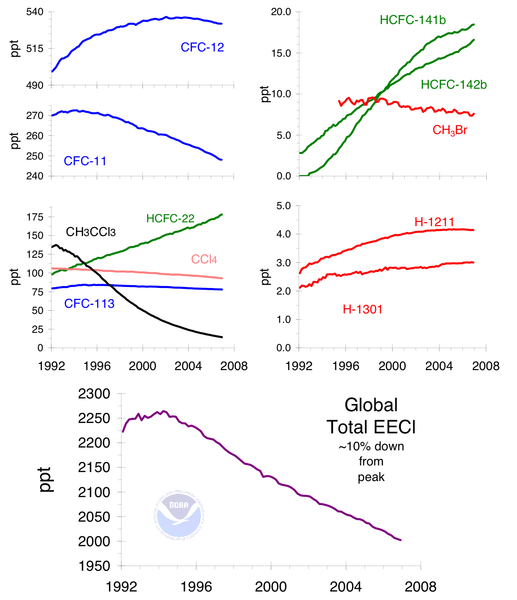Datei:Ozone cfc trends.png

Originaldatei (1.096 × 1.271 Pixel, Dateigröße: 123 KB, MIME-Typ: image/png)
Diese Datei stammt aus Wikimedia Commons und kann von anderen Projekten verwendet werden. Die Beschreibung von deren Dateibeschreibungsseite wird unten angezeigt.
Inhaltsverzeichnis
Beschreibung
| BeschreibungOzone cfc trends.png |
English: Ozone-depleting gas trends and equivalent chlorine effect. Combined chlorine and bromine in the lower atmosphere or troposphere from the most abundant chlorinated and brominated chemicals controlled by the Montreal Protocol. These changes are reflected in the upper atmosphere stratosphere (10-25 km), where most ozone loss occurs, with a delay (due to air transport) of 3-5 years. Bromine is included as an ozone-depleting chemical because although it is not as abundant as chlorine, it is 45 to 60 times more effective per atom in destroying stratospheric ozone. Earlier measurements showed that the peak of equivalent chlorine (chlorine + 45 (or 60) times bromine) occurred at the surface between mid-1992 and mid-1994.[1]
The observed decrease is driven by a large and rapid decline in methyl chloroform and methyl bromide, gases that are regulated internationally by the Montreal Protocol. The initial decline in methyl bromide was larger than that expected from projections given in the WMO/UNEP 2002 Scientific Assessment to Ozone Depletion.[2][3]
Français : Tendances pour les gaz appauvrissant la couche d'ozone (et effet en équivalent-chlore). Chlore et brome sont les halogènes destructeurs d'ozone les plus abondants, ils sont contrôlés par le Protocole de Montréal qui a permis leur réduction globale dans la haute atmosphère stratosphère (10-25 km), où la plupart de l'ozone se crée. Les effets apparaissent avec un retard de 3 à 5 ans (dû au transport aérien des CFC). Le brome est bien moins abondant que le chlore, mais il est 45 à 60 fois plus efficace par atome pour détruire l'ozone stratosphérique. Des mesures antérieures ont montré que le pic en «équivalent-chlore» (chlore + 45 (ou 60) fois brome) s'est produit à la surface entre mi-1992 et mi-1994 [1]. La diminution observée est due à une baisse importante et rapide du chloroforme de méthyle et du bromure de méthyle, pesticide et biocide gazeux réglementés mondialement par le Protocole de Montréal|Protocole de Montréal. La baisse initiale du bromure de méthyle a été plus importante qu'attendue par les projections de l’évaluation scientifique OMM / PNUE de 2002 sur l’appauvrissement de la couche d’ozone. [2] [3] |
| Quelle |
Übertragen aus en.wikipedia nach Commons durch Maksim. ftp://140.172.192.211/hats/Total_Cl_Br/totCl_2004.ps from CMDL Data Archive: http://www.cmdl.noaa.gov/info/ftpdata.html |
| Urheber |
Bei dieser Datei fehlen Angaben zum Autor.
|
| Andere Versionen |
|
Dieses Bild muss aus folgendem Grund aktualisiert werden: Last updated in 2005 Du könntest zusätzlich auch einen Zeitstempel auf das Bild setzen.
|

|
Dieses Bild des Typs Graph sollte als Vektorgrafik im SVG-Format neu erstellt werden. Vektorformate haben zahlreiche Vorteile; weitere Information unter Commons:Media for cleanup. Wenn dir eine SVG-Version dieses Bildes vorliegt, so lade diese bitte hoch. Nach dem Hochladen der Datei ist diese Vorlage auf der aktuellen Bildbeschreibungsseite durch die Vorlage {{Vector version available}}, oder kürzer {{Vva}}, zu ersetzen. Es ist empfohlen die neue SVG-Datei „Ozone cfc trends.svg“ zu nennen – dann benötigt die Vorlage vector version available (bzw. vva) keinen Parameter.
|
Lizenz
| Public domainPublic domainfalsefalse |
Diese Datei ist gemeinfrei (public domain), weil sie Material enthält, das von einem Angestellten der National Oceanic and Atmospheric Administration im Verlaufe seiner offiziellen Arbeit erstellt wurde.
العربية ∙ čeština ∙ Deutsch ∙ Zazaki ∙ English ∙ español ∙ eesti ∙ suomi ∙ français ∙ hrvatski ∙ magyar ∙ italiano ∙ 日本語 ∙ 한국어 ∙ македонски ∙ മലയാളം ∙ Plattdüütsch ∙ Nederlands ∙ polski ∙ português ∙ română ∙ русский ∙ sicilianu ∙ slovenščina ∙ Türkçe ∙ Tiếng Việt ∙ 简体中文 ∙ 繁體中文 ∙ +/− |
 |
References
- ↑ a b News Release Feb 6, 2001. Climate Monitoring and Data Laboratory (March 17). Archived from the original on 2006-09-29. Retrieved on 2006-01-15.
- ↑ a b CMDL Scientists find that ozone-depleting bromine is now on the decline. Climate Monitoring and Data Laboratory (June 9). Archived from the original on 2006-09-29. Retrieved on 2006-01-15.
- ↑ a b Halocarbons and other Atmospheric Trace Species. Climate Monitoring and Data Laboratory Summary Report #27 (March 17). Archived from the original on 2007-02-21. Retrieved on 2006-01-15.
Original edit history
| Version vom | Benutzer | Kommentar |
|---|---|---|
| 9. Juni 2005, 20:44 | en:User:SEWilco | /* References */ more complete version |
| 2. April 2005, 21:16 | en:User:SEWilco | link to 3rd reference |
| 2. April 2005, 15:34 | en:User:Mozzerati | /* References */ make into numbered list, but what's the last reference? It's not used? See [[Wikipedia:Footnote3]] |
| 2. April 2005, 15:33 | en:User:Mozzerati | update {{endnote| template to be {{note| according to recent consensus. See [[Wikipedia:Footnote3]] and talk page. |
| 18. März 2005, 06:32 | en:User:SEWilco | updates |
| 18. März 3005, 05:33 | en:User:SEWilco | updates |
| 18. März 2005, 05:11 | en:User:SEWilco | CFC gas trends. ==Related images== <gallery> Image:Major greenhouse gas trends.png|Greenhouse gas trends </gallery> ==Source== {{PD-USGov-DOC-NOAA}} Source: http://www.cmdl.noaa.gov/hats/graphs/graphs.html or ftp://ftp.cmdl.noaa.gov/hats/graphs/ |
Dateiversionen
Klicke auf einen Zeitpunkt, um diese Version zu laden.
| Version vom | Vorschaubild | Maße | Benutzer | Kommentar | |
|---|---|---|---|---|---|
| aktuell | 00:00, 3. Okt. 2016 |  | 1.096 × 1.271 (123 KB) | wikimediacommons>Cmdrjameson | Compressed with pngout. Reduced by 46kB (27% decrease). |
Dateiverwendung
Die folgende Seite verwendet diese Datei:
Metadaten
Diese Datei enthält weitere Informationen, die in der Regel von der Digitalkamera oder dem verwendeten Scanner stammen. Durch nachträgliche Bearbeitung der Originaldatei können einige Details verändert worden sein.
| Horizontale Auflösung | 59,06 dpc |
|---|---|
| Vertikale Auflösung | 59,06 dpc |
